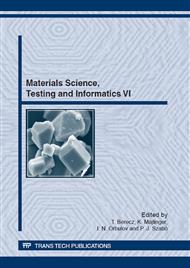p.144
p.150
p.156
p.162
p.169
p.175
p.181
p.187
p.193
Validation of New Mathematical Model of Flank Wear by Different Methods
Abstract:
Having reviewed the literature on cutting and based on the optical, electron-optical and morphological examinations of wear processes we have reached the conclusion that it is possible to describe the abrasive, adhesive and thermally activated diffusion, oxidation processes in a single mathematical model. The model is a non-linear autonomous differential equation, which can be solved by simple numerical methods. The complex wear equation was validated by the results of the cutting tests performed with P20 carbide on C45 carbon steel. If we have this data, we can calculate the activation energy of the process determining the nature of the wear process. The apparent activation energy of wear is Q=151,7kJ/mol. The model can even be used with changing technological parameters, and the data necessary for the constants of the wear equation may as well be determined even by measurements performed on the tool during industrial manufacturing. By the mean of this data, we can calculate the activation energy determining the nature of the wear process.
Info:
Periodical:
Pages:
169-174
Citation:
Online since:
November 2012
Authors:
Keywords:
Price:
Сopyright:
© 2013 Trans Tech Publications Ltd. All Rights Reserved
Share:
Citation:


